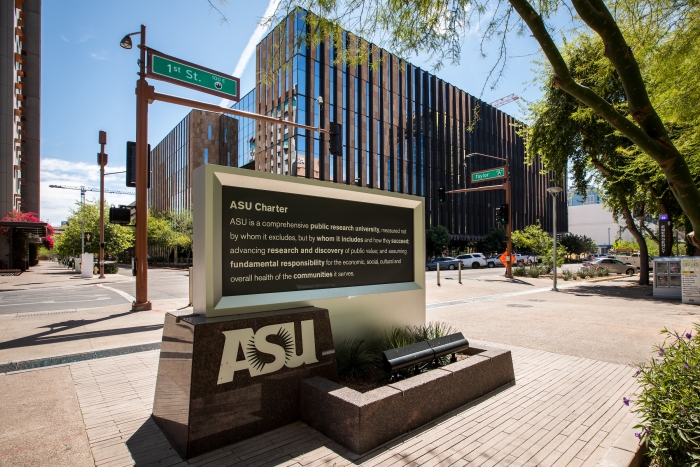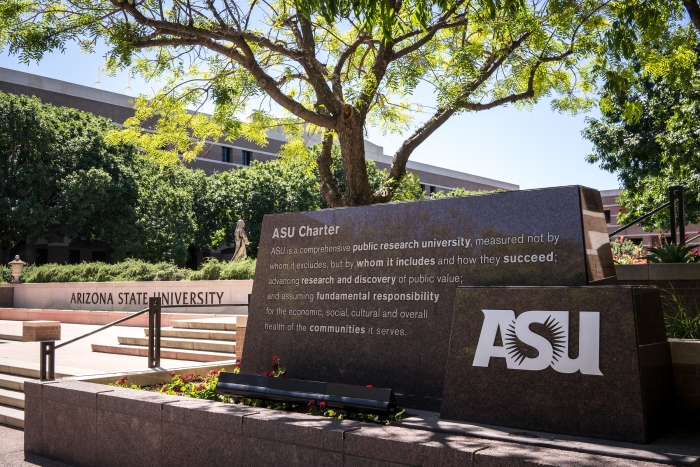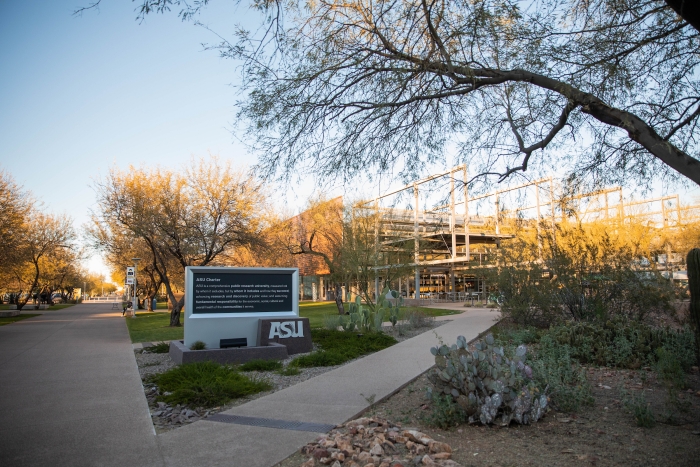ASU as the 'New American University' sets the model for higher education reform

The charter monument at the Tempe campus. The charter was presented to the Trustees of ASU on Nov. 12, 2014. Photo by Deanna Dent/Arizona State University
Arizona State University’s charter is only 46 words long, but it’s a bold promise that’s a model for the reinvention of higher education.
The document, formally introduced by ASU President Michael Crow to the Trustees of ASU on Nov. 12, 2014, set out the university’s commitment to the inclusion and success of not only its students, but also the wider community.
ASU is a comprehensive public research university, measured not by whom it excludes, but by whom it includes and how they succeed; advancing research and discovery of public value; and assuming fundamental responsibility for the economic, social, cultural and overall health of the communities it serves.
While the charter was officially announced in 2014, the concept was birthed on the day that Crow was inaugurated, in 2002. Nearly halfway into his inauguration speech, he said:
“I want to propose to you a new model for an American research university. One that measures its academic quality by the education that its graduates have received rather than the credentials of its incoming classes, one at which researchers while pursuing scholarly interests also consider the public good. … One that does not just engage in community service but rather takes on responsibility for the economic, social and cultural health of its community.”
The idea had been percolating for years as Crow saw Columbia University, where he was then executive vice provost, and other higher education institutions become increasingly static and insular — and ever more expensive.
He drew from books — including “The Creation of the Future: The Role of the American University” by Frank Rhodes and “A University for the 21st Century” by James Duderstadt, and from philosophers he studied, such as Lorenz Von Stein.
“(Von Stein) had this theory of the role of the public entity like us. He says, ‘The most important thing is to have some identification of yourself that you aspire to be,’” Crow said.
“I became kind of obsessed with the notion of how you could design a new kind of university.”
He had turned down several university presidencies, but when the job came open at ASU, he took it.
“I was familiar with Arizona and I thought this was the one place where there was enough open-mindedness and the one place where the faculty culture was still committed to the people that you could birth a new kind of new American university,” he said.
His first day was July 1, 2002, and he used the summer to brainstorm his “New American University” concept.
“I spent all that time basically talking to people in the community, going to softball games and baseball games and church meetings and community meetings and everything that you could imagine. And listening, listening, listening.”
He also worked hard to get faculty on board — a group not always open to change.
Nancy Gonzales, now the executive vice president and university provost, said that when the charter concept was debated by faculty, they had a range of reactions. She was then an associate professor in the psychology department.
“I think there were faculty who said, ‘No, that’s never going to work,’ because the idea of excellence and access being combined was revolutionary for higher education.
“There were probably plenty of faculty who were just sort of neutral about it.
“And then there were faculty, and this is the category I was in, who said, ‘This is the reason I'm in academia — to do exactly what's outlined in this charter.’ So I loved it,” Gonzales said.
And some of the skeptics have changed their minds.
“So many have come back around to say, 'Aha, I doubted it, but now I've done something that makes me so proud and I realize how powerful this is,'" she said.
One example was online education, a key component of expanding access, although some faculty resisted it. Then they tried it.
“And they said, ‘Wow, not only is this really good, it's actually better than what I've been doing. And I've now gone back and rethought how I've been teaching now that I understand these new ways of doing things,’” she said.
The charter is a great recruitment tool. When Gonzales was associate dean of faculty in The College of Liberal Arts and Sciences, she did a lot of hiring.
“And I would love to see how by the time they got to me, and they had been in meeting after meeting after meeting, it had clicked, and they would leave knowing about the charter,” she said.
Now, people who are seeking leadership positions will mention the charter in their applications.
“They’ve heard about it, they've read about it, they know the president, and that's what they want,” she said.
Along with the charter is a set of goals that lays out what the university will do. One of the goals for student success is “undifferentiated outcomes based on family income.”
“We don't have that yet,” Crow said.
“I can still predict your success at the institution based partly on your family income. We have a lot of performance goals that we still need to hit.”
And that success has to be achieved at scale — not just at ASU.
“Most people that have gone to colleges or universities of the United States have no diploma. The majority of people with debt have no diploma or certificate, nothing. And that's a failure.
“We have to demonstrate the institution's ability to think about all people, not just the people that come to college,” Crow said.
The mission to widen accessibility, enhance student success and increase local impact plays out every day in the ASU community.
Here are 10 of those stories to celebrate 10 years since the launch of the charter:
Empowering youth in Maryvale
Allison Mullady, director of the Design Studio for Community Solutions in the Watts College of Public Service & Community Solutions
The Design Studio was created in 2018 with the $30 million naming gift from Mike and Cindy Watts, owners of Sunstate Equipment Co., and the main project is the Maryvale One Square Mile Initiative.
From its creation, the mission has been to work with the Maryvale community, not swoop in with pre-conceived plans. The 10-year gift allowed time for dozens of meetings over the years, with neighborhood groups, school districts and health care providers, which has led to strong partnerships.
“The community of Maryvale is very robust and there's a lot of things already happening that are really positive and great,” Mullady said.
“We want the community to feel that we're genuinely there to support their goals and their social health."
Mullady said feedback from the community led to a focus on young people. Projects include a Youth Leadership Program, financial literacy classes, a volleyball league and a youth justice lab with the School of Criminology and Criminal Justice that helps people with juvenile records get access to jobs, housing and scholarships.
The young people wanted to beautify the local canal path, so they canvassed the neighborhood, met with the Phoenix Streets Department and with their local city council member, then interviewed local artists and hired one to paint a mural.
“They’ve had all these really great experiences around civic engagement and leadership and have been really engaged in it because it's something they've wanted to do,” she said.
“We try to hold ourselves to a very high standard of how we engage with people because of the charter and wanting to represent ASU.”
A different student population
Ayanna Thompson, Regents Professor of English and executive director, Arizona Center for Medieval and Renaissance Studies
Almost every time she has a speaking engagement, Thompson talks about the charter.
“It explains why I'm here and not at Yale or Harvard or Princeton,” she said.
“I am really, really committed to the fact that we want to be judged by whom we include and how they succeed. To me, that is everything about what the best of education is,” she said.
“And I don't want to be at an institution that values itself based on how many people they reject. It just seems to me insane in this moment in the 21st century.”
She believes other universities will have to join in the ASU charter’s mission.
“We can't go in the same direction that we've been going for the past 150 years of higher ed in the U.S.,” she said.
Thompson has used the charter to recruit nationally regarded faculty members, though they sometimes think it’s too good to be true — until they start teaching.
“This is just a different student population. They're so hungry. They're here because it's really important for their lives and for their families,” she said.
After 10 years, the charter is still aspirational, she said.
“I would say that we would have written a bad charter if it was, ‘Check. Check. Check. We’re doing these things so we’re fine,’” she said.
“We want something that keeps us aspiring to be better.”
Building a sense of community
Sedra Shahin, student body president, West Valley campus
Shahin wasn’t necessarily aware of the charter when she came to ASU as a first-year student, but as she got very involved with student clubs, she learned more.
“During my training in student government, they brought up the charter on a slideshow and I was like, ‘This is everything we stand for.’”
Shahin, who is a triple major in business administration, business law, and public service and public policy, is grateful that she gets to apply the ideals of the charter in her position.
“Inclusion was one of the pillars that I ran on,” she said.
So she and the other members of the student government hosted a weeklong “ASU 202” fair on the West Valley campus with a different theme each day to connect students to resources — such as “career day,” “major day” and “club day.”
“It focused on making sure that everybody feels included and that they have a sense of community,” she said.
“As a student leader, I honestly feel privileged to be able to help carry out this mission.”
Evolving with student needs
Ina Seok, director of the Student Success Center
The charter is one of the reasons Seok came to ASU nearly two years ago.
“I’m new to higher education, so I really wanted to hold onto this idea of inclusion and accessibility that I had as a K–12 school leader,” she said.
“The charter is so well crafted in terms of the holistic point of view. It’s not just being inclusive — it’s also making sure that the folks we include are being successful.”
Since she’s arrived, Seok has added innovative ways of coaching students, infusing art or outdoor activities into the coaching time and placing coaches into the classroom to support students.
“We’re evolving with student needs and not just doing the same thing that we did many years ago and then hoping that it works for this generation of students.”
'It's an energy'
Kielli Lilavois, associate director of academic support for the College of Integrative Sciences and Arts, Polytechnic campus
Lilavois will celebrate 25 years as an ASU employee on Nov. 8 and she’s supported a wide variety of students, including student-athletes and those in exploratory majors. Now, she works with students with academic integrity issues and she also supervises schedulers.
She remembers that in 2014, employees received cards with the charter printed on them.
“My supervisor said, ‘OK, here’s the charter.’ I knew it was a really big deal to work with students and that no matter the situation, whatever the boundary is in their mind, we’re going to help them,” she said.
Lilavois was explaining the charter to her mother and said, “It’s an energy.”
“I go, ‘Mom, it means we don't exclude anyone no matter the barrier. Is it financial? Is it emotional? We’re going to start you from square one. We’re going to get you the support you need.’
“I can call someone in admissions or I can call someone in career services or I can call President Crow.”
Seeing the difference at ASU
Jason Marcuson, executive director of enterprise education, ASU Learning Enterprise
Before Marcuson came to ASU two years ago, he worked in a company that partnered with many universities.
“And I could definitely see a difference,” he said. “This place just definitely had the innovation component, the ways they wanted to open access to people no matter where they were in life. You don’t see that everywhere.”
Marcuson works with corporate partners to create workforce development.
“So if they need leadership training or they are looking to upskill on AI or sustainability, we can team up with all of the great subject matter experts around the university to create whatever that company needs to enable their talent,” he said.
The Learning Enterprise offers education across the life spectrum, including in the workforce.
“One of my favorite things we do here is provide that chance to have access back in,” Marcuson said.
Everyone gets the same chance
Shania Lee, biomedical engineering graduate student, Tempe campus
Lee has been able to put the charter into practice through her activities as a student, including her time with The Difference Engine at ASU, an interdisciplinary center based at the Downtown Phoenix campus in which students and faculty collaborate to address social equity issues. She was a researcher for the Women’s Power and Influence Index, which rates 66 companies for pay equity, career growth, workplace standards and work-life balance.
“We quantified each company in terms of their benefits for women, such as maternity leave and the wage gap, which we looked into a lot because it’s still a huge inequality issue,” said Lee, who also earned her bachelor’s degree in biomedical engineering at ASU.
She also worked as a success coach at Global Launch, the ASU unit that teaches English and welcomes international students.
“There are a lot of frustrations that come with someone not understanding you all the time. So I did a lot of making sure they were in a good head space and letting them talk about anything, like if they’re missing their family,” said Lee, who is originally from Malaysia.
“Global Launch is honestly such an amazing small community at ASU.”
Lee often walks past the charter monument on the Tempe campus.
“I really like it because it’s about accepting anyone regardless of your background and everyone gets the same chance to get their education,” she said.
Sharing the tough parts
Jocelyne Moore, success coach at EdPlus at ASU
Moore works with students in the Starbucks College Achievement Plan, which covers tuition for more than 150 ASU Online degree programs for people who work at Starbucks.
“The thing that resonates with me is that ASU doesn’t just admit them and say, ‘You're left to your own devices.' We have a whole support system that's built into it,” she said.
Moore steps up as soon as her students enroll in their first class, coaching them on time management and connecting them with other ASU resources, such as tutoring, counseling or career services.
“I tell my students that I'm here to be your cheerleader, but also your guide as you go through your degree,” she said.
Moore is excited to see several of her students graduate this December.
“It’s nice to be there for the good parts, but also the tough parts and see them realize, ‘I can do this. I can get through tough things.’”
Inclusion at the interpersonal level
Martine Garcia, assistant director of strategic initiatives, ASU Career Services
Garcia supports first-generation, undocumented and DACA students, along with other historically underrepresented students.
Garcia was at ASU as an undergraduate, grad student, management intern and then professional staff — a total of eight years. When he was a student worker, he began to feel the importance of the charter.
“It’s been really great to measure the work compared to the charter and make sure that all the pieces fit,” he said.
Recently, Garcia used a $20,000 grant from Ford to create programming to meet the needs of first-generations students, who told him they wanted more industry connections. He set up events including a networking practice and an etiquette dinner.
Garcia thinks about inclusion at the interpersonal level.
“True inclusion happens in those everyday moments. So I think about how I interact with students in a way that embodies the charter every day. And how do I set up my staff members to be in a space where they can do that every day, every hour?
“It’s important to be reminded that we’re walking the walk and embodying what it means.”
Improving the health of the community
Susan Norton, assistant director of sustainability practices, Polytechnic campus
Norton created and runs the Garden Commons at the Polytechnic campus, which she believes is a perfect example of inclusivity. It’s open to any student, staff, faculty or community member.
“What I really like in the charter is ‘discovery of public value.’ A lot of the students are discovering urban agriculture, gardening and hyper-local produce and what that means for the first time at the Garden Commons. That feels really exciting to me,” she said.
“We have a citrus orchard. We have a fully functioning compost pile. We have pretty much a business of running a farm stand. We have the actual growing process. We start our own seedlings. So there's just lots of different ways to feel that and experience it.”
The Garden Commons is also a place to unwind.
“It’s a wonderful experience for them to let go and not think about coursework and have an outdoor experience,” she said.
“The tactile experience of sight, smell and touch in the garden definitely helps mental well-being.”
The garden is organic and seasonal, and everything used is biodegradable.
“It’s definitely healthy for our community,” she said.
More University news

Edison Awards announces Michael M. Crow as 2025 Achievement Award honoree
FORT MYERS, Fla. — The Edison Awards, an organization dedicated to honoring the world's most innovative new products and services, is pleased to announce Michael M. Crow, president of Arizona…
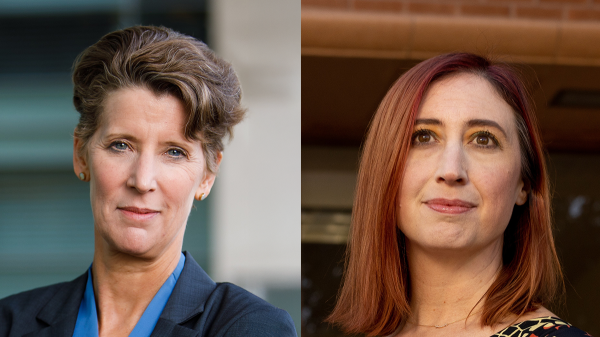
2 ASU faculty members elected to prestigious National Academy of Medicine
Two distinguished Arizona State University faculty members have been elected to the National Academy of Medicine.Sally C. Morton, executive vice president of ASU Knowledge Enterprise, and…
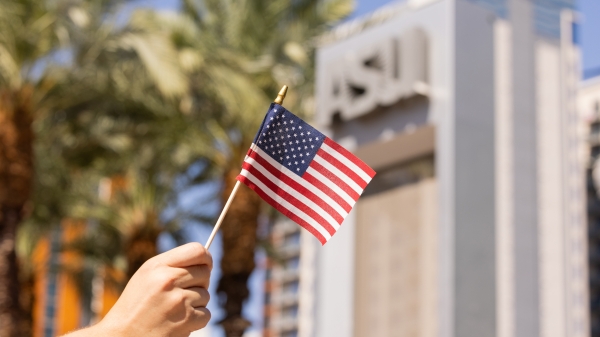
ASU establishes Center for Free Speech, will host annual free speech forum
Arizona State University is establishing a new Center for Free Speech to encourage the uninhibited exchange of ideas, and the university will launch an annual free speech forum that will begin in…
